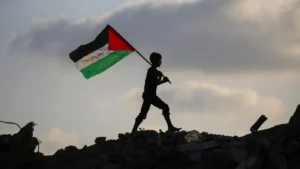In destroying Gaza, Israel destroyed its own image as a moral enterprise

A displaced child waves a Palestinian flag as he walks on the rubble of a building in Gaza’s Bureij refugee camp, on 22 September 2025
David Hearst writes in Middle East Eye on 9 October 2025:
This has been the longest, bloodiest and most destructive war fought by Israel against the Palestinians in the history of this conflict.
It will end in theatrics, largely orchestrated by US President Donald Trump, who will fly to Israel to welcome home the hostages who are still alive. There could also be a declaration, at the insistence of Hamas and Qatar, of a formal end to the war. Israeli forces will pull back from all major cities in Gaza, and United Nations trucks will roll again into the enclave – for the moment.
But make no mistake: there is no agreement yet on the second or third phases of the deal, covering the disarmament of Hamas and the imposition of an international mandate to govern Gaza. And there is not likely to be.
Trump’s view of the losses Hamas has sustained in two years of war is, to put it mildly, at some variance with reality. The US president recently said that Hamas was on the brink of destruction, with its leadership wiped out and 25,000 fighters killed – roughly half of its fighting force.
Hamas’s own assessment of the battle damage is that its institutional integrity, command and control, and communications have all withstood the severest of tests, including assassinations of top leaders, along with the several Hiroshimas’ worth of high-powered explosives that Israel has dropped on Gaza.
It has as many fighters as it did at the start of the war, and can draw upon a virtually unlimited amount of small arms and explosives to fashion anti-tank rockets and improvised explosive devices.
Hamas, which is designated as a terrorist group in the UK and other countries, does not regard itself as a defeated force – still less one that is now obliged to bend to Israel’s military will. The same is true for the other fighting factions in Gaza.
Far from ‘peace in our time’
The popularity of Hamas in Gaza has withstood the war, and in the occupied West Bank, it has increased. On Arab streets, and particularly in Jordan, the popularity of al-Qassam Brigades has reached legendary status.
There is no way it regards this moment in history, of all moments, as an end to armed conflict, as Trump and Israeli Prime Minister Benjamin Netanyahu claim.
In the view of Hamas, a long-term hudna, or “pause”, in the fighting could only come about if Israel agrees to withdraw to the 1967 lines, and ends the occupation of Gaza, the West Bank and East Jerusalem.
The group is in even less mood to allow an international body to take over Gaza, thus returning to the colonial days of the British Mandate, which began just over a century ago.
Clearly, this is very far from the “peace in our time” Trump will proclaim it to be – even if it marks the end of one particularly brutal and prolonged battle.
Hamas, other militant factions, and above all, the population of Gaza can claim strategic successes. They thwarted Israel’s most serious attempt at mass displacement since 1967. The population withstood a genocide.
It did all of this on its own. The support of neighbouring Arab states has been woefully lacking, and the only reason Egypt or Jordan blocked mass population transfer was to secure their own national interests. It was not out of any sympathy for Palestinians.
Yet staying on the land came at a huge cost: more than 67,000 lives, not counting all the bodies that are still under rubble, and the destruction of almost all of Gaza’s housing stock, hospitals, schools, mosques, and institutions. The population of Gaza will be traumatised, suffering the effects of starvation for all their lives.
